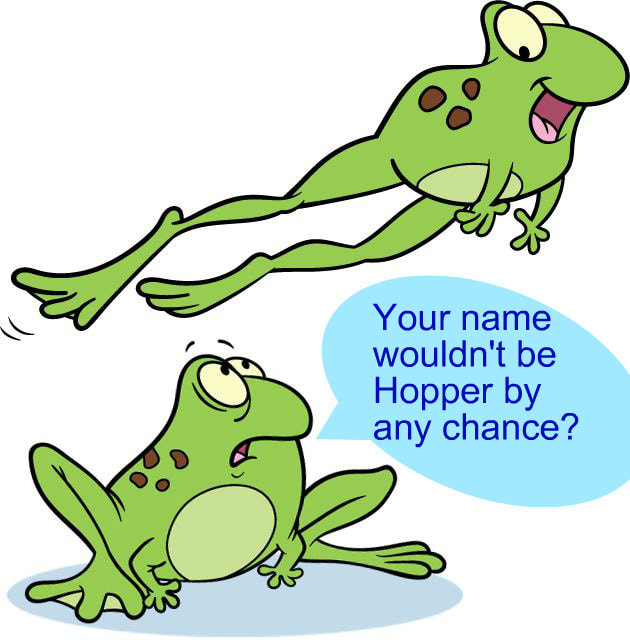Surnames are last names that are generally passed down through the males in the family. But did you know that surnames have only been around for roughly 1 thousand years? prior to that, they were necessary. The world was far less crowded back then and everybody knew everybody else by their first name. This was pretty easy to accomplish since most folks never ventured more than a few miles from the place where they were born. Even kings got away with having only a single name.
During the Middle Ages, families got bigger and the villages became more crowded. Knowing someone's first name was no longer an adequate way of identifying that person. So extensions were added on; John the son of William was distinguished from John the (black) smith. These secondary names weren't yet surnames, at least as we know them today; they weren't passed down from father to son. John, son of William might have a son who was called Robert the fletcher (arrow maker). Last names that didn't change from one generation to the next first came into use in Europe about 1000 A.D. "In many countries, hereditary surnames began with nobility who often called themselves after their ancestral seats. Many of the gentries, however, did not adopt surnames until the 14th century, and it was not until about 1500 A.D. that most surnames became inherited and no longer transformed with a change in a person's appearance, job, or place of residence."
Surnames, for the most part, drew their meanings from the lives of men in the Middle Ages, and their origins can be divided into four main categories:
1. Patronymics - last names derived from the father's name. This is especially true in Scandinavian countries. Every so often, the mother's name contributed to the surname. These are called matronymics. Either way, a prefix or a suffix was added denoting "son of" or "daughter of." English and Scandinavian names ending in son are patronymic names. So too are some prefixes; the Gaelic "Mac," the Norman "Fitz," The Irish "O," and the Welsh "ap."
2. Place names or local names - One of the most common ways to differentiate one man from his neighbor was to describe him by his geographic location or surroundings. Such local names made up some of the earliest surnames in France, but soon spread to England by the Norman nobility. "If a person or family migrated from one place to another, they were often identified by the place they came from. If they lived near a stream, cliff, forest, hill, or other geographic feature, this might be used to describe them. Some last names can still be traced back to their exact places of origin, such as a particular city or county, while others have origins lost in obscurity." At wood lived near a wood, but which one? Compass directions were sometimes used, as well, ie Westwood or Northfield. While many geographically-based surnames are easy to spot, some are not. Dunlop, for instances, means "muddy hill." Easier ones might include Churchill (he lived near a church on a hill,) Neville came from Neville-Seine-Maritime, France or Neuville (New Town), a
commonplace name in France; Parris came from—you guessed it—Paris, France.
3. Descriptive names (Nicknames) - These are some of the easiest to figure out because they were based, originally, on someone's physical appearance that became a nickname. Examples might include Broadhead (someone who had a large head), Baines (bones) was a thin man, and Armstrong had, you guessed it, strong arms! Names like Black might have come from having black hair and Strong originated from someone who was powerfully-built.
4. Occupational names - These names developed from the occupation or status of the first bearer. Miller ground grain, Taylor made and repaired clothing, Bishop was a clergyman, Carter was a maker/driver of carts, and Clark was a clerk, probably in a mercantile. Sometimes the surname is a foreign language version of a trade; i.e, (Müller, for example, is German for Miller).
Despite these four basic surname classifications, some names defy explanation. The majority of these probably came from some corruption of the original surname. Surname spellings and pronunciations have also changed over time. Many European family names have been Americanized, as well. One of the most famous is Drumpf...which we now call Trump. Drumpf is a Bavarian word for drum. "It is fairly common for different branches of the same family to carry different last names, as the majority of English and American surnames have, in their history, appeared in four to more than a dozen variant spellings."
It is important, in researching your family name that you work your way back through the generations to determine what was the original family name. It is also important to remember that some surnames, though their origins may appear obvious, aren't what they seem. Banker, for example, is not an occupational surname, instead meaning "dweller on a hillside."
So where does the surname Wart come from? No one is really sure, but Grandpa Wart tells the story about a young green frog many generations ago who fell in love with a toad. He thought her textured skin was so beautiful that he began calling himself Wart, as a way to honor his young bride.
I hope you'll join me back here tomorrow for an interesting look at Sea Turtles.
Until then, I wish you
PEACE.

 RSS Feed
RSS Feed